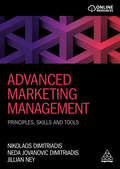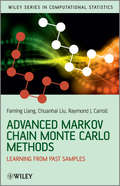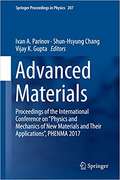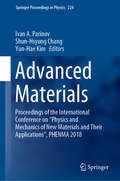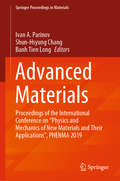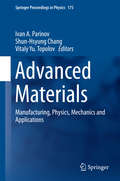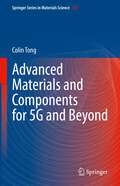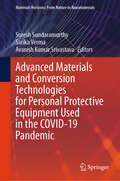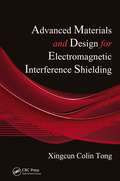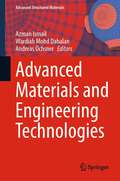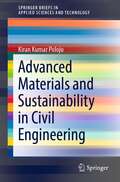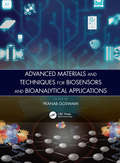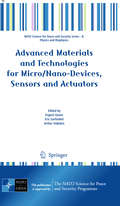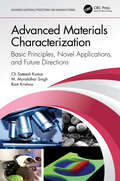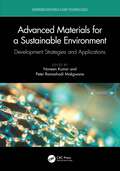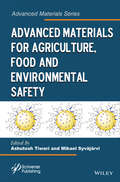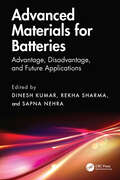- Table View
- List View
Advanced Marketing Management: Principles, Skills and Tools
by Dr Nikolaos Dimitriadis Neda Jovanovic Dimitriadis Dr Jillian NeyMarketing as a practice is facing unprecedented challenges: a changing media landscape, an increasingly complex customer journey, innovative technologies, start-ups which disrupt traditional channels and a new generation of tech-savvy clients. How should students and practitioners adapt to this shifting landscape and address the skills gap that many of today's marketers face? Advanced Marketing Management prepares students for this new world of marketing. Since traditional marketing approaches fail to provide convincing solutions to modern business realities, a new approach is urgently needed if marketers are to regain trust within their organizations. Using contemporary examples, business case studies and supporting pedagogy, Advanced Marketing Management will provide a critical exploration into the more advanced aspects of marketing management, including the gap that exists between formal marketing literature and real-world practice, discussion of multidisciplinary tools, and the crucial evolution of the '4Ps'. Summarizing a large body of literature and academic research on new developments, this book is the go-to guide for students, lecturers and practitioners, wanting to succeed as modern marketers.
Advanced Markov Chain Monte Carlo Methods
by Faming Liang Raymond Carroll Chuanhai LiuMarkov Chain Monte Carlo (MCMC) methods are now an indispensable tool in scientific computing. This book discusses recent developments of MCMC methods with an emphasis on those making use of past sample information during simulations. The application examples are drawn from diverse fields such as bioinformatics, machine learning, social science, combinatorial optimization, and computational physics.Key Features:Expanded coverage of the stochastic approximation Monte Carlo and dynamic weighting algorithms that are essentially immune to local trap problems.A detailed discussion of the Monte Carlo Metropolis-Hastings algorithm that can be used for sampling from distributions with intractable normalizing constants.Up-to-date accounts of recent developments of the Gibbs sampler.Comprehensive overviews of the population-based MCMC algorithms and the MCMC algorithms with adaptive proposals.This book can be used as a textbook or a reference book for a one-semester graduate course in statistics, computational biology, engineering, and computer sciences. Applied or theoretical researchers will also find this book beneficial.
Advanced Materials: An Introduction to Modern Materials Science
by Ajit BeheraThis book provides a thorough introduction to the essential topics in modern materials science. It brings together the spectrum of materials science topics, spanning inorganic and organic materials, nanomaterials, biomaterials, and alloys within a single cohesive and comprehensive resource. Synthesis and processing techniques, structural and crystallographic configurations, properties, classifications, process mechanisms, applications, and related numerical problems are discussed in each chapter. End-of-chapter summaries and problems are included to deepen and reinforce the reader's comprehension.Provides a cohesive and comprehensive reference on a wide range of materials and processes in modern materials science;Presents material in an engaging manner to encourage innovative practices and perspectives;Includes chapter summaries and problems at the end of every chapter for reinforcement of concepts.
Advanced Materials: Proceedings Of The International Conference On Physics And Mechanics Of New Materials And Their Applications , PHENMA 2017 (Springer Proceedings In Physics #207)
by Shun-Hsyung Chang Ivan A. Parinov Vijay K. GuptaProvides a consistent and original presentation of fabrication techniques, physics, mechanics, and applications of advanced materials and composites.<p><p> Helps readers to better understand modern R&D requirements for prospective materials and composites.<p> Features original theoretical, experimental and modeling results on novel materials and devices.<p> This book presents selected peer-reviewed contributions from the 2017 International Conference on “Physics and Mechanics of New Materials and Their Applications”, PHENMA 2017 (Jabalpur, India, 14–16 October, 2017), which is devoted to processing techniques, physics, mechanics, and applications of advanced materials. The book focuses on a wide spectrum of nanostructures, ferroelectric crystals, materials and composites as well as promising materials with special properties. It presents nanotechnology approaches, modern environmentally friendly piezoelectric and ferromagnetic techniques and physical and mechanical studies of the structural and physical–mechanical properties of materials. Various original mathematical and numerical methods are applied to the solution of different technological, mechanical and physical problems that are interesting from theoretical, modeling and experimental points of view. Further, the book highlights novel devices with high accuracy, longevity and extended capabilities to operate under wide temperature and pressure ranges and aggressive media, which show improved characteristics, thanks to the developed materials and composites, opening new possibilities for different physico-mechanical processes and phenomena
Advanced Materials: Techniques, Physics, Mechanics and Applications (Springer Proceedings in Physics #193)
by Shun-Hsyung Chang Ivan A. Parinov Muaffaq A. JaniAdvanced materials and their applications based on nanotechnology and piezoelectric approaches are a tremendous interest in modern science and techniques. This book presents processing techniques, physics, mechanics, and applications of novel materials. The book concentrates on some nanostructures, ferro- and magnetoelectric crystals, materials and composites, materials for solar cells and polymeric composites. There are present nanotechnology approaches, modern piezoelectric techniques, and also studies of the structure-sensitive properties of the materials. Great attention is devoted to novel devices with high accuracy, longevity and extended possibilities to work with wide temperature and pressure ranges, which show characteristics defined by used materials and composites with improved properties opening new possibilities in the study of various physical processes, in particular the transmission and receipt of signals under water.
Advanced Materials: Production, Characterization and Multidisciplinary Applications
by Mahendra U. Gaikwad Arpana Parihar Raju KhanAdvanced materials are engineered to exhibit novel properties that confer superior performance in comparison with conventional materials. The performance of advanced materials is associated with toughness, hardness, and durability that can be used for high technological applications such as semiconductors, biomaterials, smart materials, or nanomaterials.Advanced Materials: Production, Characterization and Multidisciplinary Applications is focused on novel approaches for production of graphene and other 2D materials along with characterization techniques, discussing a wide range of applications in multidisciplinary areas of science and engineering. It provides a guiding light in the production, synthesis, and characterization of advanced materials by implementing appropriate techniques. The book has a multidisciplinary approach covering applications in electronics (sensors), engineering, biotechnology, medical (e.g., cancer treatment, drug delivery, cellular imaging), and biomedical (smart implants, drug delivery, and DIY health testing kits) fields. The authors cover the primary information of advanced and other 2D materials related to their production or synthesis via various methods, ranging from conventional to non‑conventional – such as lithography, photolithography (computer chips), electron beam lithography, etching, atomic layer deposition, chemical vapor deposition, hydrothermal process, and electrospinning, along with some comparative investigations. It also covers a comparison study over the current and future perspectives of advanced and other 2D materials.This book is aimed at researchers, academics, and professionals who are interested in understanding the novel approaches for synthesis of advanced materials.
Advanced Materials: Proceedings of the International Conference on “Physics and Mechanics of New Materials and Their Applications”, PHENMA 2018 (Springer Proceedings in Physics #224)
by Ivan A. Parinov Shun-Hsyung Chang Yun-Hae KimThis book includes selected, peer-reviewed contributions from the 2018 International Conference on “Physics and Mechanics of New Materials and Their Applications”, PHENMA 2018, held in Busan, South Korea, 9–11 August 2018. Focusing on manufacturing techniques, physics, mechanics, and applications of modern materials with special properties, it covers a broad spectrum of nanomaterials and structures, ferroelectrics and ferromagnetics, and other advanced materials and composites. The authors discuss approaches and methods in nanotechnology; newly developed, environmentally friendly piezoelectric techniques; and physical and mechanical studies of the microstructural and other properties of materials. Further, the book presents a range of original theoretical, experimental and computational methods and their application in the solution of various technological, mechanical and physical problems. Moreover, it highlights modern devices demonstrating high accuracy, longevity and the ability to operate over wide temperature and pressure ranges or in aggressive media. The developed devices show improved characteristics due to the use of advanced materials and composites, opening new horizons in the investigation of a variety of physical and mechanical processes and phenomena.
Advanced Materials: Proceedings of the International Conference on “Physics and Mechanics of New Materials and Their Applications”, PHENMA 2019 (Springer Proceedings in Materials #6)
by Ivan A. Parinov Shun-Hsyung Chang Banh Tien LongThis book presents selected peer-reviewed contributions from the 2019 International Conference on “Physics and Mechanics of New Materials and Their Applications”, PHENMA 2019 (Hanoi, Vietnam, 7–10 November, 2019), divided into four scientific themes: processing techniques, physics, mechanics, and applications of advanced materials. The book describes a broad spectrum of promising nanostructures, crystals, materials and composites with special properties. It presents nanotechnology approaches, modern environmentally friendly techniques and physical-chemical and mechanical studies of the structural-sensitive and physical–mechanical properties of materials. The obtained results are based on new achievements in material sciences and computational approaches, methods and algorithms (in particular, finite-element and finite-difference modeling) applied to the solution of different technological, mechanical and physical problems. The obtained results have a significant interest for theory, modeling and test of advanced materials. Other results are devoted to promising devices demonstrating high accuracy, longevity and new opportunities to work effectively under critical temperatures and high pressures, in aggressive media, etc. These devices demonstrate improved comparative characteristics, caused by developed materials and composites, allowing investigation of physio-mechanical processes and phenomena based on scientific and technological progress.
Advanced Materials: Manufacturing, Physics, Mechanics and Applications (Springer Proceedings in Physics #175)
by Vitaly Yu. Topolov Shun-Hsyung Chang Ivan A. ParinovAdvanced materials are the basis of modern science and technology. This proceedings volume presents a broad spectrum of studies of novel materials covering their processing techniques, physics, mechanics, and applications. The book is concentrated on nanostructures, ferroelectric crystals, materials and composites, materials for solar cells and also polymeric composites. Nanotechnology approaches, modern piezoelectric techniques and also latest achievements in materials science, condensed matter physics, mechanics of deformable solids and numerical methods are presented. Great attention is devoted to novel devices with high accuracy, longevity and extended possibilities to work in wide temperature and pressure ranges, aggressive media etc. The characteristics of materials and composites with improved properties opening new possibilities of various physical processes, in particular transmission and receipt of signals under water, are described.
Advanced Materials and Components for 5G and Beyond (Springer Series in Materials Science #327)
by Colin TongThis book provides a comprehensive introduction to the current status and future trends of materials and component design for fifth-generation (5G) wireless communications and beyond. Necessitated by rapidly increasing numbers of mobile devices and data volumes, and acting as a driving force for innovation in information technology, 5G networks are broadly characterized by ubiquitous connectivity, extremely low latency, and very high-speed data transfer. Such capabilities are facilitated by nanoscale and massive multi-input multi-output (MIMO) with extreme base station and device densities, as well as unprecedented numbers of antennas. This book covers semiconductor solutions for 5G electronics, design and performance enhancement for 5G antennas, high frequency PCB materials and design requirements, materials for high frequency filters, EMI shielding materials and absorbers for 5G systems, thermal management materials and components, and protective packaging and sealing materials for 5G devices. It explores fundamental physics, design, and engineering aspects, as well as the full array of state-of-the-art applications of 5G-and-beyond wireless communications. Future challenges and potential trends of 5G-and-beyond applications and related materials technologies are also addressed. Throughout this book, illustrations clarify core concepts, techniques, and processes. At the end of each chapter, references serve as a gateway to the primary literature in the field. This book is essential reading for today’s students, scientists, engineers and professionals who want to understand the current status and future trends in materials advancement and component design in 5G and beyond, and acquire skills for selecting and using materials and 5G component design that takes economic and regulatory aspects into account.
Advanced Materials and Conversion Technologies for Personal Protective Equipment Used in the COVID-19 Pandemic (Materials Horizons: From Nature to Nanomaterials)
by Suresh Sundaramurthy Sarika Verma Avanish Kumar SrivastavaThis book provides an overview of the latest research on COVID-19 antiviral personal protective equipment (PPE), including safety, handling, and disposal. It also examines a range of durable, energy-efficient, and next-generation construction and building materials and energy fuel storage applications produced from PPE wastes. The topics covered include impact of PPE waste generation during COVID-19 pandemic on the environmental sustainability and its economic aspects, circular economy for advanced materials from used PPEs, conversion technologies, sustainability, reuse, and end of life materials from PPEs used in COVID-19 pandemic and microwave and plasma conversion technologies for used PPEs. The book also discusses thermo-chemical conversion technologies, various properties, and performance attributes. The book is a valuable reference for researchers and professionals in the areas of material science. It also proves as a valuable resource for policymakers and administrators involved in regulatory aspects of PPE kits.
Advanced Materials and Design for Electromagnetic Interference Shielding
by Xingcun Colin TongWith electromagnetic compliance (EMC) now a major factor in the design of all electronic products, it is crucial to understand how electromagnetic interference (EMI) shielding products are used in various industries. Focusing on the practicalities of this area, Advanced Materials and Design for Electromagnetic Interference Shielding comprehensively
Advanced Materials and Engineering Technologies (Advanced Structured Materials #162)
by Azman Ismail Wardiah Mohd Dahalan Andreas ÖchsnerThis book reports on various real-world and global engineering problems while touching on evolving design strategies. The chapters were selected from the 2nd International Conference on Marine and Advanced Technologies 2021 (ICMAT 2021). The papers discuss best practice and theory in relation to multi-disciplinary approaches in materials engineering technology. Among the topics are advanced materials, applied science, marine engineering and energy application.
Advanced Materials and Manufacturing Processes: Proceedings Of Icadma 2020 (Science, Technology, and Management)
by Amar Patnaik Malay Kumar Banerjee Ernst Kozeschnik Albano Cavaleiro J. Paulo Davim Vikas KukshalThis book discusses advanced materials and manufacturing processes with insights and overviews on tribology, automation, mechanical, biomedical, and aerospace engineering, as well as the optimization of industrial applications. The book explores the different types of composite materials while reporting on the design considerations and applications of each. Offering an overview of futuristic research areas, the book examines various engineering optimization and multi-criteria decision-making techniques and introduces a specific control framework used in analyzing processes. The book includes problem analyses and solving skills and covers different types of composite materials, their design considerations, and applications. This book is an informational resource for advanced undergraduate and graduate students, researchers, scholars, and field professionals, providing an update on the current advancements in the field of manufacturing processes.
Advanced Materials and Manufacturing Techniques for Biomedical Applications (Advances In Manufacturing, Design And Computational Intelligence Techniques Ser.)
by Arbind Prasad Ashwani Kumar Manoj GuptaADVANCED MATERIALS and MANUFACTURING TECHNIQUES for BIOMEDICAL APPLICATIONS The book provides essential knowledge for the synthesis of biomedical products, development, nanomaterial properties, fabrication processes, and design techniques for different applications, as well as process design and optimization. In origin, biomaterials can come from nature or be synthesized in the laboratory with a variety of approaches that use metals, polymers, ceramic, or composite materials. They are often used or adapted for various biomedical applications. Biomaterials are commonly used in scaffolds, orthopedic, wound healing, fracture fixation, surgical sutures, artificial organ developments, pins and screws to stabilize fractures, surgical mesh, breast implants, artificial ligaments and tendons, and drug delivery systems. The sixteen chapters in Advanced Materials and Manufacturing Techniques in Biomedical Applications cover the synthesis, processing, design, manufacturing, and characterization of advanced materials; self-healing, bioinspired, nature-resourced, nanobiomaterials for biomedical applications; and manufacturing techniques such as rapid prototyping, additive manufacturing, etc. Audience The book is for engineers, technologists, and researchers working in the area of biomedical engineering and manufacturing techniques. It is also appropriate for upper-level undergraduate and graduate students.
Advanced Materials and Structural Engineering: Proceedings of the International Conference on Advanced Materials and Engineering Structural Technology (ICAMEST 2015), April 25-26, 2015, Qingdao, China
by Jong Wan HuThe ICAMEST 2015 Conference covered new developments in advanced materials and engineering structural technology. Applications in civil, mechanical, industrial and material science are covered in this book. Providing high-quality, scholarly research, addressing developments, applications and implications in the field of structural health monitoring, construction safety and management, sensors and measurements. This volume contains new models for nonlinear structural analysis and applications of modeling identification. Furthermore, advanced chemical materials are discussed with applications in mechanical and civil engineering and for the maintenance of new materials. In addition, a new system of pressure regulating and water conveyance based on small and middle hydropower stations is discussed.An experimental investigation of the ultimate strength and behavior of the three types of steel tubular K-joints was presented. Furthermore, real-time and frequency linear and nonlinear modeling performance of materials of structures contents were concluded with the notion of a fully brittle material, and this approach is implemented in the book by outlining a finite-element method for the prediction of the construction performance and cracking patterns of arbitrary structural concrete forms. This book is an ideal reference for practicing engineers in material, mechanical and civil engineering and consultants (design, construction, maintenance), and can also be used as a reference for students in mechanical and civil engineering courses.
Advanced Materials and Sustainability in Civil Engineering (SpringerBriefs in Applied Sciences and Technology)
by Kiran Kumar PolojuThis book discusses the detailed concepts of concrete and its development with pros and cons. Besides, the significance of various industrial wastes as partial replacements with concrete ingredients such as cement and aggregates are discussed. The creation of cement contributes to around 7% of carbon emissions into the atmosphere leading to greenhouse effect and global warming. Similarly, the wastes generated from various industries such as thermal, steel, ceramic, marble, paper and etc. shows the impact on atmosphere and leads to air pollution and land pollution. Thus, it is essential to focus on these wastes to use them in a profitable manner without compromising the current needs. This book discusses a few examples on studies of using various industry wastes as partial replacement of cement in concrete
Advanced Materials and Techniques for Biosensors and Bioanalytical Applications
by Pranab GoswamiBioanalytical science and its technological subdomain, biosensors, are ever-evolving subjects, striving for rapid improvement in terms of performance and expanding the target range to meet the vast societal and market demands. The key performance factors for a biosensor that drive the research are selectivity, sensitivity, response time, accuracy, and reproducibility, with additional requirements of its portability and inexpensive nature. These performance factors are largely governed by the materials and techniques being used in these bioanalytical platforms. The selection of materials to meet these requirements is critical, as their interaction or involvement with the biological recognition elements should initiate or improve these performance factors. The technique discussed primarily applies to transducers involved in converting a biochemical signal to optical or electrical signals. Over the years, the emergence of novel materials and techniques has drastically improved the performance of these bioanalytical systems, enabling them to expand their analytical horizon. These advanced materials and techniques are central to modern bioanalytical and biosensor research. Advanced Materials and Techniques for Biosensors and Bioanalytical Applications provides a comprehensive review of the subject, including a knowledge platform for both academics and researchers. Considering biosensors as a central theme to this book, an outline on this subject with background principles has been included, with a scope of extending the utility of the book to coursework in graduate and postgraduate schools. Features: • Basic principles on different classes of biosensors, recent advances and applications • Smart materials for biosensors and other rapid, portable detection devices • Metal nanoparticles and nanocrystals for analytical applications • Carbon-based nanoparticles and quantum dots for sensing applications • Nanozymes as potential catalysts for sensing applications • Bioelectrochemiluminescence and photoelectrochemical-based biosensors • Paper electronics and paper-based biosensors • Microbial biosensors: artificial intelligence, genetic engineering, and synthetic biology • Biofuel cells as a signal transduction platform • FET-based biosensors, including ISFET and BioFET This book serves as a reference for scientific investigators and a textbook for a graduate-level course in biosensors and advanced bioanalytical techniques.
Advanced Materials and Techniques for Reinforced Concrete Structures
by Mohamed Abdallah El-Reedy Ph.DIncrease the Durability and Performance of Concrete during Its LifetimeWhile reinforced concrete is a durable material used for a wide range of construction projects in civil engineering, certain factors must be considered during its design, construction, and maintenance. This includes a variety of conditions impacting strength and performance rele
Advanced Materials and Technologies for Micro/Nano-Devices, Sensors and Actuators (NATO Science for Peace and Security Series B: Physics and Biophysics)
by Arthur Dideikin Eric Garfunkel Evgeni GusevThe main goal of this book is to review recent progress and current status of MEMS/NEMS technologies and devices. Several important areas are discussed: history of research in the field, device physics, examples of sucessful applications, sensors, materials and processing aspects. The authors who have contributed to the book represent a diverse group of leading scientists from academic, industrial and governmental labs worldwide who bring a broad array of backgrounds such as device physics, technologists, electrical and mechanical engineering, surface chemistry and materials science). The contributions to this book are accessible to both expert scientists and engineers who need to keep up with leading edge research, and newcomers to the field who wish to learn more about the exciting basic and applied research issues relevant to micromechanical devices and technologies.
Advanced Materials and Technologies for Wastewater Treatment (Emerging Materials and Technologies)
by Sreedevi Upadhyayula Amita ChaudharyAdvanced Materials and Technologies for Wastewater Treatment discusses the methods and technologies of physical, chemical, biological, and thermo-catalytic treatment techniques. It includes the treatment of waste generated by municipal, agro-industry, and other industries including chemical, biomedical, pharmaceutical, textile, and other sectors. FEATURES Covers implementation of advanced water and wastewater treatment techniques, with a focus on pollutant or pathogen removal Includes qualitative and quantitative analyses Focuses on physical, chemical, and biological treatment technologies Discusses the advancements of materials and technologies applicable to both potable water and wastewater from industrial and municipal sources Explores future challenges and viable solutions This book is aimed at chemical and environmental engineers and researchers seeking a thorough treatment of innovative water treatment materials and techniques for practical applications.
Advanced Materials Characterization: Basic Principles, Novel Applications, and Future Directions (Advanced Materials Processing and Manufacturing)
by Ch Sateesh Kumar M. Muralidhar Singh Ram KrishnaThe book covers various methods of characterization of advanced materials commonly used in engineering including understanding of the working principle and applicability of devices. It explores the techniques implemented for advanced materials like superalloys, thin films, powders, nanocomposites, polymers, shape memory alloys, high entropy alloys, and so on. Major instruments covered include X-ray diffraction, near-field scanning optical microscopy Raman, X-ray photospectroscopy, ultraviolet-visible-near-infrared spectrosphotometer, Fourier-transform infrared spectroscopy, differential scanning calorimeter, profilometer, and thermogravimetric analysis. Features: Covers material characterization techniques and the development of advanced characterization technology Includes multiple length scale characterization approaches for a large variety of materials, from nano- to micron-scale, as well as their constraints Discusses advanced material characterization technology in the microstructural and property characterization fields Reviews both practical and theoretical explanations of approaches for characterizing microstructure and properties Offers fundamentals, basic instrumentation details, experimental approaches, analyses, and applications with case studies This book is aimed at graduate students and researchers in materials science and engineering.
Advanced Materials for a Sustainable Environment: Development Strategies and Applications (Emerging Materials and Technologies)
by Peter Ramashadi Makgwane Naveen KumarThis book summarizes recent and critical aspects of advanced materials for environmental protection and remediation. It explores the various development aspects related to environmental remediation, including design and development of novel and highly efficient materials, aimed at environmental sustainability. Synthesis of advanced materials with desirable physicochemical properties and applications is covered as well. Distributed across 13 chapters, the major topics covered include sensing and elimination of contaminants and hazardous materials via advanced materials along with hydrogen energy, biofuels, and CO2 capture technology. Discusses the development in design of synthesis process and materials with sustainable approach. Covers removal of biotic and abiotic wastes from the aqueous systems. Includes hydrogen energy and biofuels under green energy production. Explores removal of environmental (soil and air) contaminants with nanomaterials. Reviews advanced materials for environmental remediation in both liquid and gas phases.
Advanced Materials for Agriculture, Food and Environmental Safety (Advanced Material Series)
by Ashutosh Tiwari Mikael SyväjärviThe levels of toxic and microbial contamination in the food and environment are influenced by harvesting or slaughtering technologies and by the processes applied during food manufacture. With current cultivation methods, it is impossible to guarantee the absence of pesticides and pathogenic microorganisms in raw foods, both of plant and animal origin. Widespread and increasing incidence of foodborne diseases and the resulting social and economic impact on the world population have brought food and environmental safety to the forefront of ecological safety and public health concerns. The emerging field of advanced materials based on functional architectures offers potential solutions to some of the key performance challenges along with the improved sensitivity, longevity, stability, miniaturization and ruggedness, while reducing complexity and production cost. The overall purpose of this book is to generate new solutions to the technical challenges in easy and rapid detections of food toxicants, microorganisms and environmental pollutants. The book focuses on the role of advanced materials in the food, water and environmental applications The monitoring of harmful organisms and toxicants in water, food and beverages is mainly discussed in the respective chapters. The senior contributors write on the following topics: Layered double hydroxides and environment Corrosion resistance of aluminium alloys of silanes New generation material for the removal of arsenic from water Prediction and optimization of heavy clay products quality Enhancement of physical and mechanical properties of fiber Environment friendly acrylates latices Nanoparticles for trace analysis of toxins Recent development on gold nanomaterial as catalyst Nanosized metal oxide based adsorbents for heavy metal removal Phytosynthesized transition metal nanoparticles- novel functional agents for textiles Kinetics and equilibrium modeling Magnetic nanoparticles for heavy metal removal Potential applications of nanoparticles as antipathogens Gas barrier properties of biopolymer based nanocomposites: Application in food packing Application of zero-valent iron nanoparticles for environmental clean up Environmental application of novel TiO2 nanoparticles
Advanced Materials for Batteries: Advantage, Disadvantage, and Future Applications
by Dinesh Kumar Rekha Sharma Sapna NehraThe rise of renewable energy responds to global warming, necessitating reliable storage like batteries. Though frequent use can affect their lifespan, these have become smaller, simpler, and more adaptable. Recent technological progress has improved batteries' longevity and efficiency, with costs dropping due to mass production. This book examines different battery types, their evolution, and the cutting-edge materials enhancing their performance, particularly focusing on metal oxides in various battery technologies.Exploring advanced materials for batteries is not just a theoretical exercise but a practical journey into the future of energy. This book is an essential guide, tracing the evolution from early battery technology to the latest innovations and equipping researchers, engineers, and students with the practical knowledge to drive the next wave of sustainable energy solutions.Key Features:· Provides a comprehensive resource for academics, researchers, and engineers in energy storage, with detailed insights into various battery types.· Discusses advanced materials for smart and small batteries.· Delves into cutting-edge materials designed for compact and efficient batteries.· Offers a visionary outlook on the evolution of battery technology and traces historical advances alongside the latest breakthroughs in battery science and future perspectives.This book serves as a beacon, bridging historical milestones with future goals. It thoroughly explores materials, including lithium-ion and sodium-ion, in a manner accessible to everyone. It lays a robust groundwork for innovators in energy storage, steering us towards a more sustainable tomorrow. This work informs and connects readers to the evolving narrative of battery technology.
